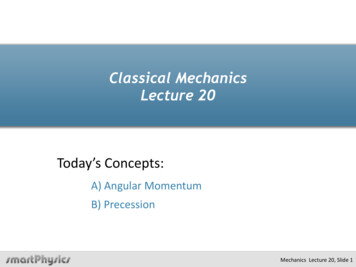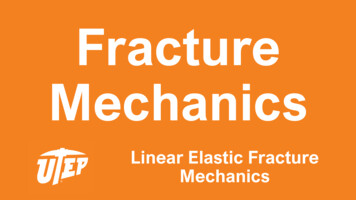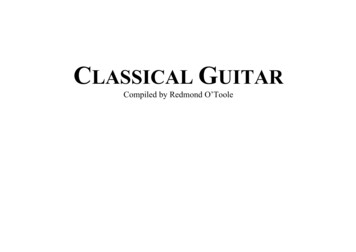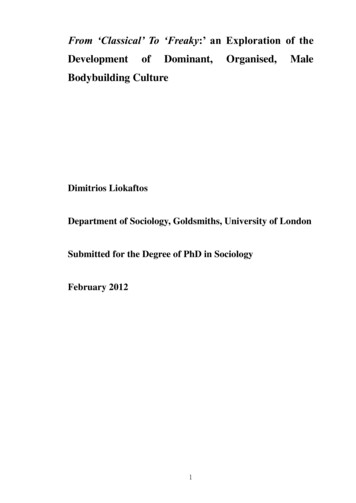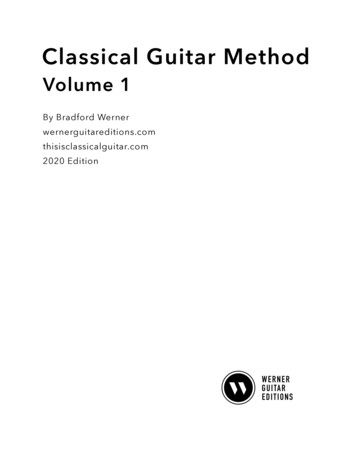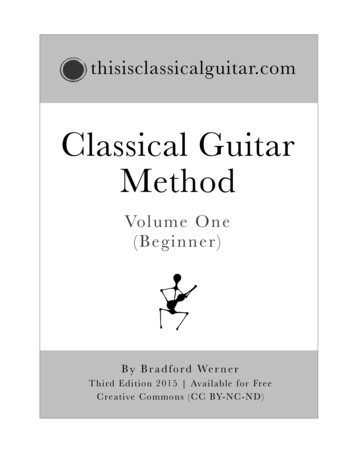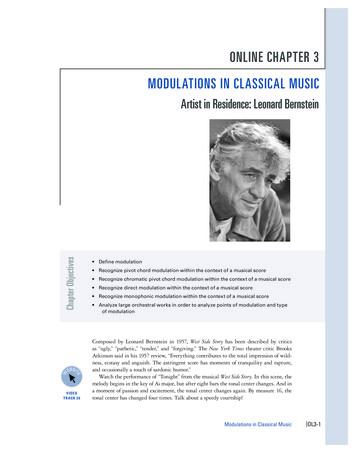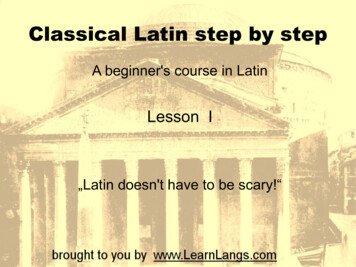
Transcription
Classical MechanicsAn introductory courseRichard FitzpatrickAssociate Professor of PhysicsThe University of Texas at Austin
Contents1 Introduction71.1 Major sources: . . . . . . . . . . . . . . . . . . . . . . . . . . . . . . . . . . . . . .71.2 What is classical mechanics? . . . . . . . . . . . . . . . . . . . . . . . . . . . . . . .71.3 mks units . . . . . . . . . . . . . . . . . . . . . . . . . . . . . . . . . . . . . . . . .91.4 Standard prefixes . . . . . . . . . . . . . . . . . . . . . . . . . . . . . . . . . . . . . 101.5 Other units . . . . . . . . . . . . . . . . . . . . . . . . . . . . . . . . . . . . . . . . 111.6 Precision and significant figures . . . . . . . . . . . . . . . . . . . . . . . . . . . . . 121.7 Dimensional analysis . . . . . . . . . . . . . . . . . . . . . . . . . . . . . . . . . . . 122 Motion in 1 dimension182.1 Introduction . . . . . . . . . . . . . . . . . . . . . . . . . . . . . . . . . . . . . . . . 182.2 Displacement . . . . . . . . . . . . . . . . . . . . . . . . . . . . . . . . . . . . . . . 182.3 Velocity . . . . . . . . . . . . . . . . . . . . . . . . . . . . . . . . . . . . . . . . . . 192.4 Acceleration . . . . . . . . . . . . . . . . . . . . . . . . . . . . . . . . . . . . . . . . 212.5 Motion with constant velocity . . . . . . . . . . . . . . . . . . . . . . . . . . . . . . 232.6 Motion with constant acceleration. . . . . . . . . . . . . . . . . . . . . . . . . . . 242.7 Free-fall under gravity . . . . . . . . . . . . . . . . . . . . . . . . . . . . . . . . . . 263 Motion in 3 dimensions323.1 Introduction . . . . . . . . . . . . . . . . . . . . . . . . . . . . . . . . . . . . . . . . 323.2 Cartesian coordinates. . . . . . . . . . . . . . . . . . . . . . . . . . . . . . . . . . 323.3 Vector displacement . . . . . . . . . . . . . . . . . . . . . . . . . . . . . . . . . . . 333.4 Vector addition . . . . . . . . . . . . . . . . . . . . . . . . . . . . . . . . . . . . . . 343.5 Vector magnitude . . . . . . . . . . . . . . . . . . . . . . . . . . . . . . . . . . . . . 352
3.6 Scalar multiplication . . . . . . . . . . . . . . . . . . . . . . . . . . . . . . . . . . . 353.7 Diagonals of a parallelogram. . . . . . . . . . . . . . . . . . . . . . . . . . . . . . 363.8 Vector velocity and vector acceleration . . . . . . . . . . . . . . . . . . . . . . . . . 373.9 Motion with constant velocity . . . . . . . . . . . . . . . . . . . . . . . . . . . . . . 393.10 Motion with constant acceleration. . . . . . . . . . . . . . . . . . . . . . . . . . . 393.11 Projectile motion . . . . . . . . . . . . . . . . . . . . . . . . . . . . . . . . . . . . . 413.12 Relative velocity. . . . . . . . . . . . . . . . . . . . . . . . . . . . . . . . . . . . . 444 Newton’s laws of motion534.1 Introduction . . . . . . . . . . . . . . . . . . . . . . . . . . . . . . . . . . . . . . . . 534.2 Newton’s first law of motion . . . . . . . . . . . . . . . . . . . . . . . . . . . . . . . 534.3 Newton’s second law of motion . . . . . . . . . . . . . . . . . . . . . . . . . . . . . 544.4 Hooke’s law . . . . . . . . . . . . . . . . . . . . . . . . . . . . . . . . . . . . . . . . 554.5 Newton’s third law of motion . . . . . . . . . . . . . . . . . . . . . . . . . . . . . . 564.6 Mass and weight . . . . . . . . . . . . . . . . . . . . . . . . . . . . . . . . . . . . . 574.7 Strings, pulleys, and inclines . . . . . . . . . . . . . . . . . . . . . . . . . . . . . . . 604.8 Friction . . . . . . . . . . . . . . . . . . . . . . . . . . . . . . . . . . . . . . . . . . 674.9 Frames of reference . . . . . . . . . . . . . . . . . . . . . . . . . . . . . . . . . . . . 705 Conservation of energy785.1 Introduction . . . . . . . . . . . . . . . . . . . . . . . . . . . . . . . . . . . . . . . . 785.2 Energy conservation during free-fall . . . . . . . . . . . . . . . . . . . . . . . . . . 785.3 Work . . . . . . . . . . . . . . . . . . . . . . . . . . . . . . . . . . . . . . . . . . . . 815.4 Conservative and non-conservative force-fields . . . . . . . . . . . . . . . . . . . . . 885.5 Potential energy . . . . . . . . . . . . . . . . . . . . . . . . . . . . . . . . . . . . . . 923
5.6 Hooke’s law . . . . . . . . . . . . . . . . . . . . . . . . . . . . . . . . . . . . . . . . 935.7 Motion in a general 1-dimensional potential . . . . . . . . . . . . . . . . . . . . . . 965.8 Power . . . . . . . . . . . . . . . . . . . . . . . . . . . . . . . . . . . . . . . . . . . 996 Conservation of momentum1076.1 Introduction . . . . . . . . . . . . . . . . . . . . . . . . . . . . . . . . . . . . . . . . 1076.2 Two-component systems . . . . . . . . . . . . . . . . . . . . . . . . . . . . . . . . . 1076.3 Multi-component systems . . . . . . . . . . . . . . . . . . . . . . . . . . . . . . . . 1126.4 Rocket science. . . . . . . . . . . . . . . . . . . . . . . . . . . . . . . . . . . . . . 1156.5 Impulses . . . . . . . . . . . . . . . . . . . . . . . . . . . . . . . . . . . . . . . . . . 1186.6 Collisions in 1-dimension. . . . . . . . . . . . . . . . . . . . . . . . . . . . . . . . 1216.7 Collisions in 2-dimensions . . . . . . . . . . . . . . . . . . . . . . . . . . . . . . . . 1277 Circular motion1367.1 Introduction . . . . . . . . . . . . . . . . . . . . . . . . . . . . . . . . . . . . . . . . 1367.2 Uniform circular motion . . . . . . . . . . . . . . . . . . . . . . . . . . . . . . . . . 1367.3 Centripetal acceleration . . . . . . . . . . . . . . . . . . . . . . . . . . . . . . . . . 1387.4 The conical pendulum . . . . . . . . . . . . . . . . . . . . . . . . . . . . . . . . . . 1417.5 Non-uniform circular motion . . . . . . . . . . . . . . . . . . . . . . . . . . . . . . 1427.6 The vertical pendulum . . . . . . . . . . . . . . . . . . . . . . . . . . . . . . . . . . 1487.7 Motion on curved surfaces . . . . . . . . . . . . . . . . . . . . . . . . . . . . . . . . 1508 Rotational motion1608.1 Introduction . . . . . . . . . . . . . . . . . . . . . . . . . . . . . . . . . . . . . . . . 1608.2 Rigid body rotation . . . . . . . . . . . . . . . . . . . . . . . . . . . . . . . . . . . . 1608.3 Is rotation a vector? . . . . . . . . . . . . . . . . . . . . . . . . . . . . . . . . . . . 1624
8.4 The vector product . . . . . . . . . . . . . . . . . . . . . . . . . . . . . . . . . . . . 1668.5 Centre of mass . . . . . . . . . . . . . . . . . . . . . . . . . . . . . . . . . . . . . . 1688.6 Moment of inertia. . . . . . . . . . . . . . . . . . . . . . . . . . . . . . . . . . . . 1728.7 Torque . . . . . . . . . . . . . . . . . . . . . . . . . . . . . . . . . . . . . . . . . . . 1798.8 Power and work. . . . . . . . . . . . . . . . . . . . . . . . . . . . . . . . . . . . . 1848.9 Translational motion versus rotational motion . . . . . . . . . . . . . . . . . . . . . 1868.10 The physics of baseball . . . . . . . . . . . . . . . . . . . . . . . . . . . . . . . . . . 1868.11 Combined translational and rotational motion . . . . . . . . . . . . . . . . . . . . . 1909 Angular momentum2049.1 Introduction . . . . . . . . . . . . . . . . . . . . . . . . . . . . . . . . . . . . . . . . 2049.2 Angular momentum of a point particle . . . . . . . . . . . . . . . . . . . . . . . . . 2049.3 Angular momentum of an extended object . . . . . . . . . . . . . . . . . . . . . . . 2069.4 Angular momentum of a multi-component system . . . . . . . . . . . . . . . . . . . 20910 Statics21710.1 Introduction . . . . . . . . . . . . . . . . . . . . . . . . . . . . . . . . . . . . . . . . 21710.2 The principles of statics . . . . . . . . . . . . . . . . . . . . . . . . . . . . . . . . . 21710.3 Equilibrium of a laminar object in a gravitational field . . . . . . . . . . . . . . . . 22010.4 Rods and cables . . . . . . . . . . . . . . . . . . . . . . . . . . . . . . . . . . . . . . 22310.5 Ladders and walls . . . . . . . . . . . . . . . . . . . . . . . . . . . . . . . . . . . . . 22610.6 Jointed rods . . . . . . . . . . . . . . . . . . . . . . . . . . . . . . . . . . . . . . . . 22811 Oscillatory motion23711.1 Introduction . . . . . . . . . . . . . . . . . . . . . . . . . . . . . . . . . . . . . . . . 23711.2 Simple harmonic motion . . . . . . . . . . . . . . . . . . . . . . . . . . . . . . . . . 2375
11.3 The torsion pendulum . . . . . . . . . . . . . . . . . . . . . . . . . . . . . . . . . . 24111.4 The simple pendulum . . . . . . . . . . . . . . . . . . . . . . . . . . . . . . . . . . 24211.5 The compound pendulum . . . . . . . . . . . . . . . . . . . . . . . . . . . . . . . . 24511.6 Uniform circular motion . . . . . . . . . . . . . . . . . . . . . . . . . . . . . . . . . 24612 Orbital motion25312.1 Introduction . . . . . . . . . . . . . . . . . . . . . . . . . . . . . . . . . . . . . . . . 25312.2 Historical background . . . . . . . . . . . . . . . . . . . . . . . . . . . . . . . . . . 25312.3 Gravity . . . . . . . . . . . . . . . . . . . . . . . . . . . . . . . . . . . . . . . . . . . 26212.4 Gravitational potential energy . . . . . . . . . . . . . . . . . . . . . . . . . . . . . . 26512.5 Satellite orbits . . . . . . . . . . . . . . . . . . . . . . . . . . . . . . . . . . . . . . . 26812.6 Planetary orbits . . . . . . . . . . . . . . . . . . . . . . . . . . . . . . . . . . . . . . 26913 Wave motion27913.1 Introduction . . . . . . . . . . . . . . . . . . . . . . . . . . . . . . . . . . . . . . . . 27913.2 Waves on a stretched string . . . . . . . . . . . . . . . . . . . . . . . . . . . . . . . 27913.3 General waves . . . . . . . . . . . . . . . . . . . . . . . . . . . . . . . . . . . . . . 28413.4 Wave-pulses . . . . . . . . . . . . . . . . . . . . . . . . . . . . . . . . . . . . . . . . 28513.5 Standing waves . . . . . . . . . . . . . . . . . . . . . . . . . . . . . . . . . . . . . . 28913.6 The Doppler effect . . . . . . . . . . . . . . . . . . . . . . . . . . . . . . . . . . . . 2916
1 INTRODUCTION1Introduction1.1 Major sources:The sources which I consulted most frequently whilst developing this course are:Analytical Mechanics: G.R. Fowles, Third edition (Holt, Rinehart, & Winston, NewYork NY, 1977).Physics: R. Resnick, D. Halliday, and K.S. Krane, Fourth edition, Vol. 1 (John Wiley& Sons, New York NY, 1992).Encyclopædia Brittanica: Fifteenth edition (Encyclopædia Brittanica, Chicago IL,1994).Physics for scientists and engineers: R.A. Serway, and R.J. Beichner, Fifth edition,Vol. 1 (Saunders College Publishing, Orlando FL, 2000).1.2 What is classical mechanics?Classical mechanics is the study of the motion of bodies (including the specialcase in which bodies remain at rest) in accordance with the general principlesfirst enunciated by Sir Isaac Newton in his Philosophiae Naturalis Principia Mathematica (1687), commonly known as the Principia. Classical mechanics was thefirst branch of Physics to be discovered, and is the foundation upon which allother branches of Physics are built. Moreover, classical mechanics has many important applications in other areas of science, such as Astronomy (e.g., celestialmechanics), Chemistry (e.g., the dynamics of molecular collisions), Geology (e.g.,the propagation of seismic waves, generated by earthquakes, through the Earth’scrust), and Engineering (e.g., the equilibrium and stability of structures). Classical mechanics is also of great significance outside the realm of science. After all,the sequence of events leading to the discovery of classical mechanics—startingwith the ground-breaking work of Copernicus, continuing with the researches ofGalileo, Kepler, and Descartes, and culminating in the monumental achievements7
1 INTRODUCTION1.2 What is classical mechanics?of Newton—involved the complete overthrow of the Aristotelian picture of theUniverse, which had previously prevailed for more than a millennium, and itsreplacement by a recognizably modern picture in which humankind no longerplayed a privileged role.In our investigation of classical mechanics we shall study many different typesof motion, including:Translational motion—motion by which a body shifts from one point in space toanother (e.g., the motion of a bullet fired from a gun).Rotational motion—motion by which an extended body changes orientation, withrespect to other bodies in space, without changing position (e.g., the motionof a spinning top).Oscillatory motion—motion which continually repeats in time with a fixed period(e.g., the motion of a pendulum in a grandfather clock).Circular motion—motion by which a body executes a circular orbit about anotherfixed body [e.g., the (approximate) motion of the Earth about the Sun].Of course, these different types of motion can be combined: for instance, themotion of a properly bowled bowling ball consists of a combination of translational and rotational motion, whereas wave propagation is a combination oftranslational and oscillatory motion. Furthermore, the above mentioned types ofmotion are not entirely distinct: e.g., circular motion contains elements of bothrotational and oscillatory motion. We shall also study statics: i.e., the subdivisionof mechanics which is concerned with the forces that act on bodies at rest andin equilibrium. Statics is obviously of great importance in civil engineering: forinstance, the principles of statics were used to design the building in which thislecture is taking place, so as to ensure that it does not collapse.8
1 INTRODUCTION1.3 mks units1.3 mks unitsThe first principle of any exact science is measurement. In mechanics there arethree fundamental quantities which are subject to measurement:1. Intervals in space: i.e., lengths.2. Quantities of inertia, or mass, possessed by various bodies.3. Intervals in time.Any other type of measurement in mechanics can be reduced to some combination of measurements of these three quantities.Each of the three fundamental quantities—length, mass, and time—is measured with respect to some convenient standard. The system of units currentlyused by all scientists, and most engineers, is called the mks system—after the firstinitials of the names of the units of lengt
Classical mechanics was the rst branch of Physics to be discovered, and is the foundation upon which all other branches of Physics are built. Moreover, classical mechanics has many im-portant applications in other areas of science, such as Astronomy (e.g., celestial mechanics), Chemistry (e.g., the dynamics of molecular collisions), Geology (e.g.,
